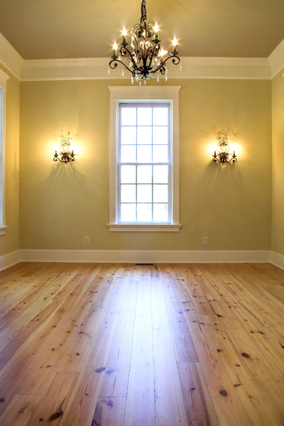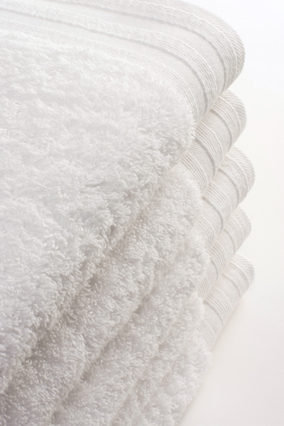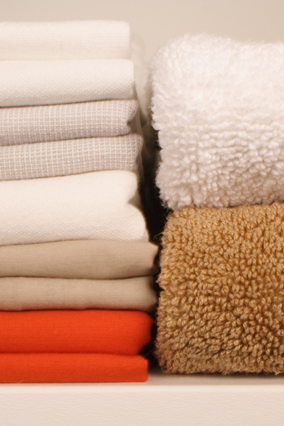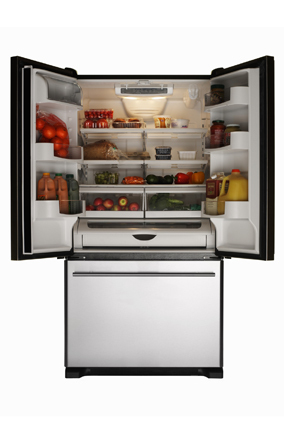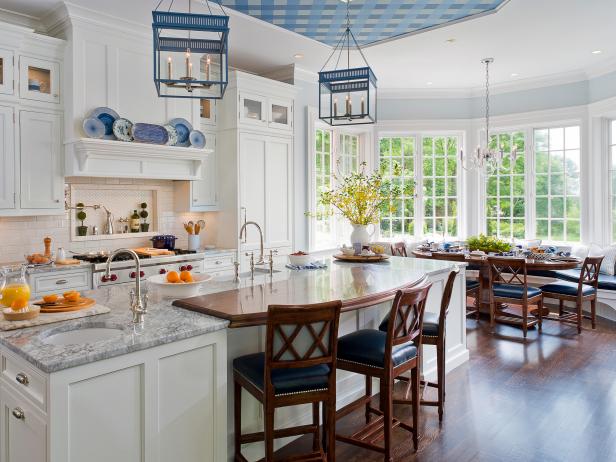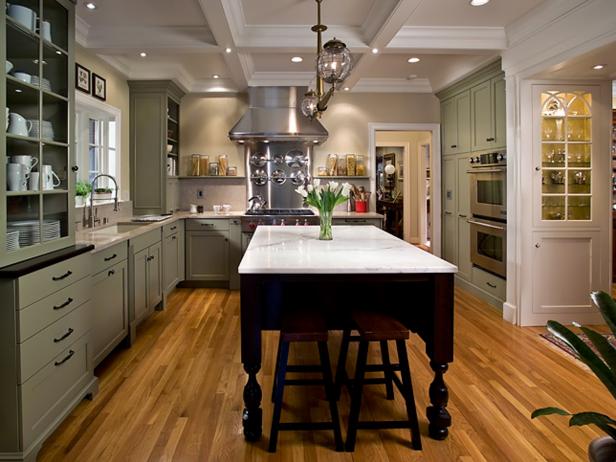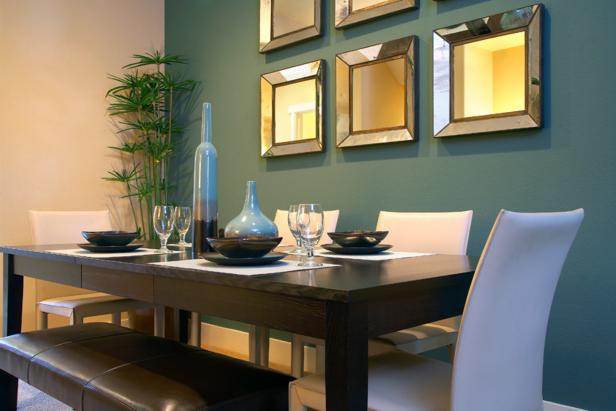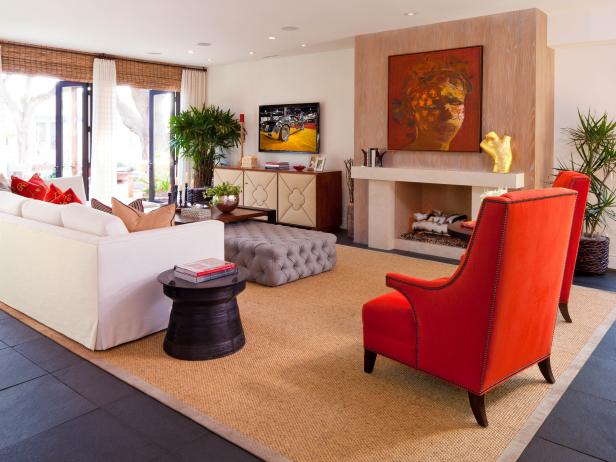Nothing compares to the soft, luxurious feeling of carpet
under your feet. Carpeting provides a safe, comfortable spot for kids
to play and may even reduce the risk of injury during a fall.
Sure, carpet requires a bit of extra maintenance compared to vinyl or
tile, but there's simply no substitute in terms of sound absorption,
warmth and overall comfort.
With so many different colors, materials and designs available, it
can be difficult to choose the best carpet for your home. Some materials
may require frequent cleanings
that simply won't fit into your busy schedule, others come with a high
price tag and some may even have an effect on your health. The wrong
carpet may wear out quickly, fade or show stains that stubbornly resist
your best cleaning efforts. Protect your investment and choose the best
carpeting for your home with these 10 carpet-buying tips.
Don't be tempted to skimp on carpet padding to save a few dollars.
Just as a building needs a solid foundation, carpeting relies on a
layer of padding for support, strength and a bit of extra cushioning.
You can't see the padding, but you'll definitely spot the extra wear and
tear on your new carpet if you pick an inadequate padding material.
Made from rubber
or foam materials, carpet padding conceals subfloor imperfections to
improve the appearance of the finished floor. It also acts as insulation
to help control the temperature of your home, and it even absorbs sound
to protect your privacy and eliminate neighbor noise. Most importantly,
padding supports your carpet through years of use, since it prevents
carpet backing and fibers from coming apart over time.
Consult your carpet manufacturer for padding recommendations and
advice. Typically, high-traffic areas require firm, dense padding, while
guest bedrooms and other light-traffic rooms may need less protection.
It's also important to match the padding to the type of carpet you
plan to use. The Carpet and Rug Institute recommends a 7/16-inch
padding with 6 pounds of density per
cubic feet to support cut pile or cut loop carpeting. For Berber or thin
loop rugs, look for a 3/8-inch pad or thinner, with 8
pounds of density per cubic foot.
Carpet
comes in many styles, including plush, Saxony, Berber, textured and
frieze. These terms apply to its pile, which is the surface you see,
created from yarn tufts that are either folded over into loops, cut
straight across or both. While each style has a distinctive look, that
shouldn't be your main consideration. Instead, look at how well your
lifestyle meshes with a particular carpet style. Plush carpeting, for
example, is made from tightly twisted pile, and is thick, soft and
inviting. But it also shows footprints and vacuum tracks, and can
develop something called "pooling," or areas that appear shaded because
the normal direction of the carpet fibers has been reversed. Saxony, the
most common type of carpeting, is similar to plush. These carpet styles work best in low-traffic areas like formal living rooms and master bedrooms.
Berber carpeting, in contrast, is crafted from continuous fiber
loops and is flat and dense. It can have a level loop, cut-and-loop or
multi-level loop design. All of these attributes mean Berber is
extremely durable and doesn't show tracks, soil and stains -- perfect
for high-traffic areas, or places frequented by kids.
Textured carpeting is made from fibers cut to different heights,
which causes them to reflect light. This makes it difficult to see
tracks and dirt. So this type of carpeting is also great for
high-traffic areas. Some Berbers are textured.
Friezes are a cut-pile carpet made from slightly twisted fibers. The
look is less formal than plush, but fancier than many textured pieces
or Berber. The carpet feels soft on your feet, yet its fuzziness hides
footprints and dirt well.
3) Don't Blow Your Budget
Even the most luxurious carpet
doesn't have to cost a fortune. Shop around to find carpet that fits
your lifestyle and budget. Always request separate pricing for materials
and installation so you can make an "apples-to-apples" comparison among
different suppliers.
Make the most of any budget by choosing the best carpet for each
room. For example, stain-resistant products may be worth the splurge in
your busy family room, but more affordable low-traffic carpeting may be
just fine for your guest rooms.
Consider lifetime replacement and maintenance expenses to keep costs
even lower. If you have kids or pets, try carpet tile instead of rolled
carpeting. Rather than replacing the entire room after a few years of
spills and stains, you can replace single tiles as needed to keep your carpet looking fresh and new.
Explore different material options before you buy to balance price
and comfort. Wool represents the very best in carpet materials but also
comes with the highest price tag. Nylon and other synthetics
feel similar to wool but are available at lower prices. For
moisture-prone areas like basements or stairways, try cut-rate options
like Olefin or polyester.
You can purchase carpet in a variety of places -- carpet showrooms,
of course, but also flooring companies, furniture stores, large
department stores and even online. While you can end up with beautiful
carpet that's expertly installed using any of these options, your best
bet is to select a reputable establishment that specializes in
carpeting.
A quality carpet store will carry a large, varied carpet selection,
including different fiber options such as wool, synthetics, blends,
sisal, linen, jute, coir and woven vinyl. Staffers should be able to
easily answer all of your questions and let you take samples home.
The quality of your carpet's installation is just as important as
the quality of the carpet itself. A second-rate job can leave you with
obvious seams, lumps, bumps and other issues, so look for stores that
employ their own installers. This can be difficult, as most carpet
dealers use subcontractors. While subcontracted carpet installers aren't
necessarily inexperienced, they do tend to be less experienced and less
skilled than full-time employees.
If you can't find a good shop with its own installers, make sure your
carpet dealer's subcontractors have worked with them for many years.
One of the best ways to ensure you'll be satisfied with your new
carpet is to stick with carpeting you can maintain easily. Homeowners
with young children or dogs and cats
may want to avoid hard-to-clean shag or high-end rugs. Stain-resistant
carpets can eliminate the frustration associated with spills and may cut
your cleaning time.
Always ask a salesperson about cleaning and maintenance requirements
before you commit to buying. Find out how often you'll need to clean
and what special equipment or products the manufacturer recommends. Skip
carpets with extensive maintenance requirements unless you have the
extra time to perform these tasks.
The type of material and carpet style you choose can also have a
major impact on maintenance. Pick textured rugs to conceal footprints
and vacuum cleaner tracks. In high traffic areas, look for textured
Saxony, level loop or high-density loop carpets to resist dirt and make
cleaning easier. You should only install cut pile and multilevel loop
carpets in low- to medium-traffic areas, as both of these designs tend
to trap dirt and resist cleaning efforts.
Carpeting
carries an insane number of possible warranties, including five- and
10-year options, matting and crushing warranties, and guarantees against
stains,
wear and even overall appearance. In general, the better quality the
carpet, the more coverage you're offered via warranties, stain
protection and the like. However, never purchase a particular carpet
solely because the warranty seems really great -- because most
warranties actually offer little true coverage.
For example, the most common warranty is a "wear" warranty.
Manufacturers offering these typically define "wear" as a bald spot,
while many homeowners consider a carpet to be worn as soon as it loses
its original appearance. Similarly, a crushing warranty may state that
if the pile height can be restored to a certain degree, there's no
issue. But most carpets' pile can be restored through hot water
extraction and a pile rake (even though it will be crushed again once
you walk on it), so manufacturers will say the warranty doesn't apply.
The most common carpet complaints aren't for manufacturing defects,
anyway, but rather for improper installation. These complaints should
generally be taken to the retailer; before you purchase a carpet,
inquire what recourse you have if you're unhappy with the installation.
With so many colors and designs available, selecting the right finish just might be the most difficult part of your carpet-buying
decision. Narrow your search by choosing shades that match the overall
mood or tone you want to set for each room. Try cool blues or greens to
create a calm, peaceful setting, and warm reds or golden shades to make a
large space feel cozier. Light colors can make small rooms feel larger
and more open, so try cream or tan if you're feeling claustrophobic.
Before settling on a neutral shade, decide whether you want your
carpet to serve as a focal point or fade into the background. Only go
neutral if your walls, furnishings or artwork serve as focal points, as this can help you avoid a plain, monotone design.
Dark shades or patterns can hide stains, as can tweed or textured
carpet designs. To make patterned rugs work with other patterns in a
room, stick to designs within the same color family.
For maximum versatility, use carpet tiles to create your own patterns
and designs or to add a border around the perimeter of the room.
Always ask for carpet samples of each color you're considering. Try
to get the biggest samples available, and take them home to examine them
in natural light before you buy. Keep in mind that sun exposure can
fade colored carpeting, so choose fade-resistant products if your carpet
will be in direct sunlight.
It's critical to select the right carpeting for your stairs,
since stairs get a lot of wear, plus the carpeting has to be bent over
the edges of each step. A cut-pile carpet is a better choice than a
looped pile, as the spaces between the loops will tend to open up where
the carpet curls over the stairs in an effect called "grinning." Looped
carpets can also snag, especially at any seams or transition areas.
Density is another factor to consider. If the carpet isn't that
thick, you may end up seeing the unsightly backing when the carpet is
curved over the steps. One test of the density is to stick your fingers
deeply into a carpet sample. If you can easily separate the fibers and
feel the backing, it's probably not the best choice for your stairs.
The ideal choice, actually, is a woven wool carpet. Woolen carpets
are the most durable, and their woven backing helps keep each piece of
yarn in place, which is especially important for stairs. Unfortunately, wool carpets are pricey.
Many people are shocked to learn just how much carpet, padding and
adhesives can impact air quality and health. If you've ever been around
brand-new carpet or other building materials, you probably remember that
distinctive "new" smell. That odor is caused by volatile organic
compounds (VOCs). VOCs, such as formaldehyde, cause poor indoor air quality and can contribute to a host of health problems, including asthma and allergies. Protect your family by choosing carpet made from natural products, including wool, jute and other organic materials. Also, look for organic or chemical-free dyes to keep toxic fumes out of your home.
In addition to impacting your health, your choice of carpet can also
affect the environment. Reduce your impact with recycled materials,
such as carpets made from recycled water bottles. Many manufacturers
also use recycled carpeting to produce new rugs, so check the
recycled-content percentage before you buy. Keep in mind that nylon and
other synthetics are made primarily from fossil fuel byproducts, so
choose renewable or recycled products for maximum sustainability.
If you want to go green but feel overwhelmed by your options,
consider eco-friendly carpet labeling programs sponsored by independent
reviews. The Carpet and Rug Institute's Green Label Plus program or the Green Seal
certification program can each provide valuable information on how
different carpet options will impact the environment and your family's
health.
It's possible you'd be better served with an area rug and not wall-to-wall carpeting.
How do you know? Consider the two. Carpeting's main advantages are that
it's soft and warm underfoot, muffles sound and provides cushioning if
you fall. It's also affordable. However, carpet holds dust, mites and
other allergens, so if members of your household have allergies
or asthma, it can be a problem. Carpet can also be difficult to clean,
holds odors like pet urine and typically wears out within about 10
years, so you'll need to re-carpet -- and sometimes not just the one
room with the really worn carpet, but the entire house, depending on
where the carpet runs.
Area rugs are a popular flooring choice because they come in a
larger variety of colors and designs, can be switched among rooms and
are quite affordable. It’s also easier to make a statement with a fun or
colorful area rug than it is with wall-to-wall carpeting, and you can
take your rug with you every time you move. The main drawback to an area
rug is that it requires you to have reasonably nice flooring underneath
it, since some of your floor will almost certainly show. If you’ve got a
beautiful hardwood floor, perfect. If you don’t, you’ll at least need a
floor that’s in reasonably good shape. The other negatives to area rugs
are that they can slip and/or be a tripping hazard if you stumble on an
edge. But you can often remedy those issues with a rug pad or
double-sided tape.








